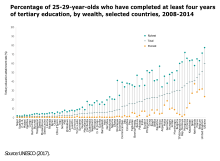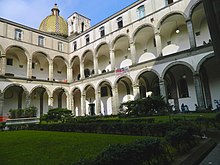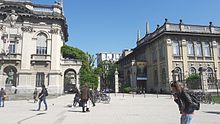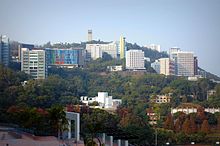Tertiary education
Sustainable Development Goal 4 (SDG 4) commits countries to providing lifelong learning opportunities for all, including tertiary education.[6] This commitment is monitored through the global indicator for target 4.3 in the sustainable development goal 4 (SDG 4), which measures the participation rate of youth and adults in formal and non-formal education and training in the previous 12 months, whether for work or non-work purposes.[8] In 1994, the UNESCO Salamanca Statement called on the international community to endorse the approach of inclusive education, including at the tertiary level.Since this time the world has witnessed the global massification of tertiary education, yet this explosion of facilities and enrollment has largely entrenched and exacerbated the exclusion of people with disabilities.[19] The oldest known institutions of higher education are credited to Dynastic Egypt, with Pr-Anx (houses of life) built as libraries and scriptoriums, containing works on law, architecture, mathematics, and medicine, and involved in the training of "swnw" and "swnwt" (male and female doctors); extant Egyptian papyri from the 3rd millennia BC are in several collections.[23] In China, the Han dynasty established chairs to teach the Five Confucean Classics, in the Grand School, Taixue (c. 3 - 1905 CE), to train cadres for the imperial administration.[26] In 425 CE, the Byzantine emperor Theodosius II innovated as he established the Pandidakterion, with a faculty of 31 professors, to train public servants.Meanwhile, the first Medresahs were founded in the Moslem empire – initially mere primary schools in the premises of major mosques, which gradually evolved toward secondary, later higher education.Their organization and purposes were markedly different from the corporations of students and teachers, independent from both the Church and the State, which established themselves from the 12th century in Western Europe as Universitas Studiorum.[43] The Israeli-funded Institute for the Study of Global Antisemitism and Policy and some Israeli media have claimed that involvement and funding by Qatar in higher education in the US has resulted in what they regard as growing anti-Semitism on campuses, in particular in connection with Israel–Hamas war protests.[44][better source needed][45] The total expenditure on tertiary education (ISCED levels 5 to 8) as a percentage of GDP for individual countries is shown in the following table The percentage of adults who have attained individual tertiary education levels by country is shown in the following table.A 2014 report by the Organisation for Economic Co-operation and Development states that by 2014, 84 percent of young people were completing upper secondary education over their lifetimes, in high-income countries.It aspires to cultivate a world-class workforce, enhance the employment rate of Canadians, and safeguard Canada's enduring prosperity.Higher education programs are intricately designed with the perspective of the learner in focus, striving to mitigate risks and assure definite outcomes.Some private institutions are affiliated with religious organizations whereas others are secular with enrollment ranging from a few dozen to tens of thousands of students.[60] The Carnegie Classification of Institutions of Higher Education provides one framework for classifying U.S. colleges and universities in several different ways.[68] Italy has a large and international network of public or state-affiliated universities and schools offering degrees in higher education.[78] In May 2008, Bocconi overtook several traditionally top global business schools in the Financial Times Executive education ranking, reaching no.















Harvard UniversityCambridge, MassachusettsUnited Stateslinear algebraHelsinki University of Technologyeducationalsecondary educationWorld Bankuniversitiescollegesvocational schoolsundergraduatepostgraduate educationvocational educationfurther educationUnited Kingdomcontinuing educationcertificatesdiplomasacademic degreesInternational Standard Classification of EducationUNESCOWorld Development ReportGermanna Community Collegeformal learningpolytechnicsprimary educationbasic educationhigh schooleducationfemalelow-income countrieshigh-income countriesSustainable Development Goal 4lifelong learningadultsinternational human rights instrumentsInternational Covenant on Economic, Social and Cultural RightsEuropeFirst Protocol to the European Convention on Human Rightsright to educationgrade inflationgraduate unemploymentcredentialismlibertarianfree tradeopen bordersEuropean Unioninternational migrationAlma MaterDaniel Chester FrenchColumbia UniversityUniversity of Bolognaacademiesseminariesconservatoriesinstitutes of technologymedical schoolsdental schoolsgraduate-levelgraduate schoolcritical thinkingteamworkinginformation literacyethicaldecision-makingproblem solvingLisbon Recognition ConventionhieroglyphsBologna Universityworld's oldest university in continuous operationFrederick II, Holy Roman EmperorUniversity of Naples Federico IIdoctorsEgyptian papyriPlato's AcademyAristotle's LyceumAlexandriaPtolemiesSouth AsiaTaxilaNalandaHan dynastyFive Confucean ClassicsTaixueTheodosius IIPandidakterionGuinness World RecordsUniversity of al-QarawiyyinFez, Moroccooldest existing continually operatingUniversity of Ez-ZitounaWorld War IIeconomiesWidening participationunderemploymentoverqualificationeducational inflationInstitute for the Study of Global Antisemitism and Policyinvolvement and funding by Qatar in higher education in the USIsrael–Hamas war protestsAustraliaAustriaBelgiumBulgariaCanadaColombiaCosta RicaCroatiaCzech RepublicDenmarkEstoniaFinlandFranceGermanyGreeceHungaryIcelandIrelandIsraelLatviaLithuaniaLuxembourgMexicoNetherlandsNew Zealand